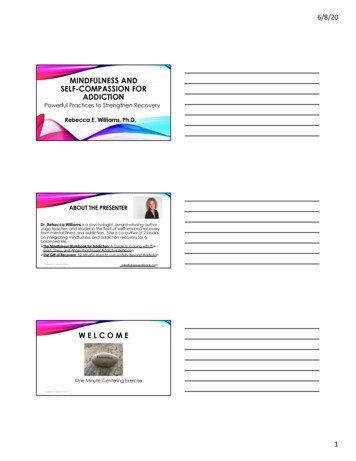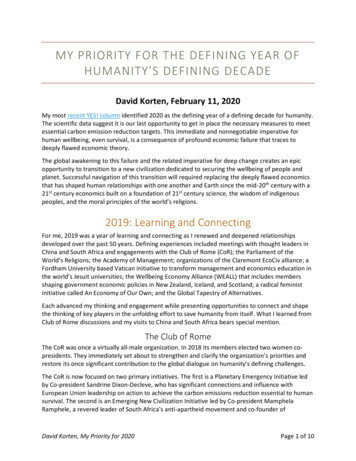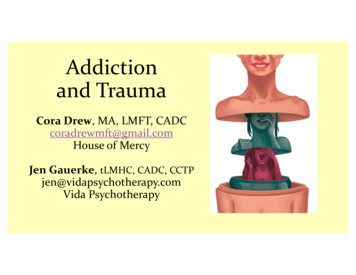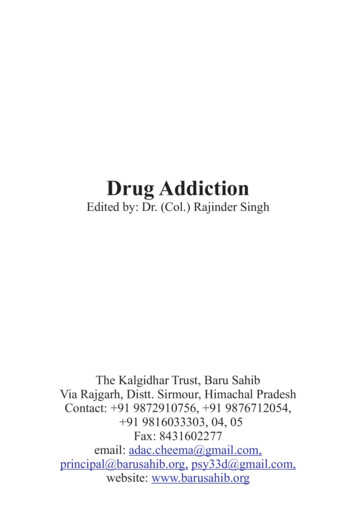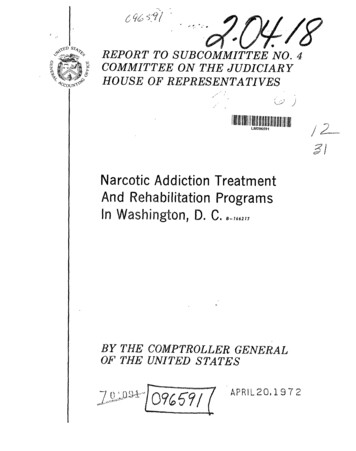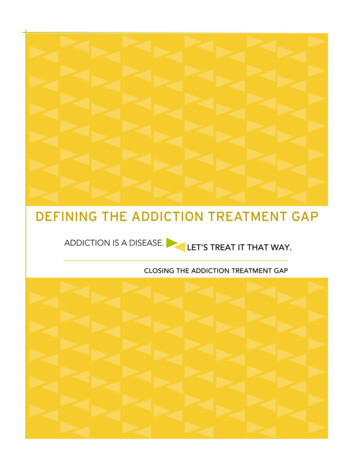
Transcription
DEFINING THE ADDICTION TREATMENT GAP
DEFINING THE ADDICTION TREATMENT GAPEXECUTIVE SummaryOur society and ourhealth care systemhave been slowto recognize andAn estimated 23.5 million AmericansAmericans will have insurance coverageare currently addicted to alcohol and/for addiction treatment as part of theiror other drugs and need treatmentbasic benefit package. This represents aand other supportive services.major step forward in making addictionUnfortunately, only one in 10 of themtreatment part of a comprehensive(2.6 million) receives the treatmentapproach to integrated health care.respond to alcoholthey need. The result: a treatment gapand drug addictionof more than 20 million Americans.as a chronic butLack of insurance, inadequate insurancetreatable condition,leaving millions ofAmericans withoutaccess to treatment.coverage and insufficient public fundsare the primary reasons for thistreatment gap.Congress embraced addictiontreatment as an essential part ofhealth care reform. But federal andstate regulators are now tasked withtranslating and implementing thatvision by defining what will be includedLike heart disease, diabetes andin the addiction treatment benefit forhypertension, addiction is a chronicboth public and private insurance. Fordisease that can be managedthe promise of this historic opportunitysuccessfully over time —as long as thereto be realized, a meaningful addictionis access to quality treatment services,treatment benefit will include a fullintegrated medical care and continuingcontinuum of effective, integratedsupport. Unfortunately, our society andtreatment practices.health care system have been slow torecognize and respond to addiction as achronic but treatable condition, leavingmillions of Americans without accessto the treatment and supportiveservices they need to sustain their longterm health.The March 2010 passage of healthThe following summary of data relatedto drug and alcohol addiction andtreatment is designed to provide astatistical context for efforts to closeAmerica’s addiction treatment gap,including the design of an addictiontreatment benefit as part of health carereform implementation.care reform means that millions of1
DEFINING THE ADDICTION TREATMENT GAPThe Face of Addiction isthe Face of AmericaThe 23 million Americans who areaddicted to alcohol or drugs come fromall walks of life.The 23 millionAmericans who areaddicted to alcoholDemographics of AddictionmalefemaleGenderor drugs representevery segment ofour society—men and35.2%women, young and64.8%old, every race andethnicity.Age 7.7%16.8%29.7%over 67.7%WhiteAfricanAmericanHispanicor LatinoOtherMost of the adults aged 18 and overwith addictions are employed: 53percent working full-time and 17.1percent working part-time.While nearly half have a high schooleducation or less, 23.3 percent arecollege graduates and nearly 27.5percent attended at least some college.The majority of those with anaddiction—18.7 million people—usealcohol. More than 7 million use drugs:Over 4 million use marijuana, 1.9million misuse pain relievers, 1.1 millionuse cocaine and fewer than 1 millioneach use tranquilizers, hallucinogens,stimulants, heroin, inhalants andsedatives. More than 3 million peopleare addicted to both alcohol and drugs.The Face of Treatment: Only10 Percent Get the AddictionTreatment They NeedIn 2009, 2.6 million people receivedtreatment for alcohol or drug problemsat a specialty facility—as inpatientsin hospitals, at drug or alcoholrehabilitation centers and/or mentalhealth centers.Like the overall population ofAmericans addicted to alcohol or drugs,those receiving treatment cut acrosscategories of age, race, and gender.2
DEFINING THE ADDICTION TREATMENT GAPDemographics of Addiction TreatmentmalefemaleGender32.3%In 2008, 2.3 million67.7%people receivedtreatment foralcohol or drugaddictions at aspecialty facility.1.3%Age10.1%11.4%28.6%over 5040-4930-3920-2915-19under Hispanicother59.6%In terms of education, 44 percent ofthose receiving treatment completedhigh school and 23.6 percent completedat least some college. Education levelswere highest among those beingtreated for addiction to sedatives,followed by those being treated forproblems with alcohol.Treatment Needs Vary: Alcoholand Four Drugs Account for NearlyAll Treatment AdmissionsFive substances accounted for 96percent of 2007 treatment admissionstracked in the Substance Abuse andMental Health Services Administration’sTreatment Episode Data Set, and 45percent of the admissions primarily foralcohol also reported problems withother drugs.Substances of Addiction4040%3530252015Nearly one third—29 percent—ofindividuals receiving addiction treatmentwere employed; 21.5 percent had fulltime jobs. Those admitted to treatmentfor alcohol only were most likely to beemployed (42 percent). The proportion ofemployed was lowest for those addictedto cocaine and heroin—16 percent each.1019%16%13%8%50AlcoholOpiates primarily heroinMarijuana/hashishCocaineStimulants, primarily methamphetamine3
DEFINING THE ADDICTION TREATMENT GAPMost Seek Treatment as OutpatientsTreatment Referral TypeThe majority of addiction treatmentstracked in 2007 was conducted throughoutpatient admission at specialtyfacilities.In 2008, one millionpeople felt they403525208015needed treatment butcould not get it—mostcite cost and lack of60insurance.5033%30Outpatient Treatment inal justice systemThemselvesSubstance abuse treatment providerHealth care providerSchoolEmployer/employee assistance programOther community referral302018%20%100Ambulatory/outpatient treatmentRehabilitation/residential programsDetoxification programsOne-Third Refer Themselves forTreatment; Fewer Than SevenPercent Are Referred By PhysiciansSlightly more than two-thirds of thosereceiving treatment got there throughself-referrals or the criminal justicesystem, while fewer than seven percentwere referred by a health provider.This provides compelling evidence thataddiction screening and treatment arenot integrated into the nation’s healthcare delivery system.Affordability and Lack of Insuranceare Main Reasons One MillionDid Not Get TreatmentIn 2009, an additional 1.1 million peoplefelt they needed treatment but did notget it. Of these, 34.9 percent say theymade an effort to get treatment. Thetop reasons these people did not getthe treatment they needed are: No health coverage and cannotafford cost (36.8 percent)Not ready to stop using(30.5 percent)Able to handle the problem withouttreatment (10.2 percent)No transportation (9.7 percent)Had health coverage but did notcover treatment or did not covercost (8.8 percent)Might have negative effect on job(8.6 percent)Might cause neighbors/community tohave negative opinion (8.5 percent).4
DEFINING THE ADDICTION TREATMENT GAPState and Local GovernmentsPay for Half of TreatmentCosts While Private InsurancePays for Only 10 PercentFunding oftreatment servicesdisproportionatelycomes from publicsources; privateinsurance coversonly 10 percent.In 2003, an estimated 21 billion wasspent on drug and alcohol addictiontreatment. This represents 1.3 percentof all health care spending for that year.In contrast to other chronic diseases,funding for addiction treatmentdisproportionately comes fromgovernment sources. More than threequarters—77 percent—of treatmentcosts are paid by federal, state andlocal governments, including Medicaidand Medicare.Total Funding of Addiction Treatment4040%Private insurance covers only 10percent of addiction treatment costs,with out-of-pocket expendituresand other private funding makingup the remaining percentage. Incontrast, private insurance pays forapproximately 37 percent of generalmedical costs. The passage of federalparity and health care reform legislationshould help address this imbalance inthe future.On an individual level, nearly half ofthose receiving treatment reportedusing their own money to pay for theircare, and 34.8 percent report usingprivate health insurance.Public Funding of Addiction ate and local governments(excluding Medicaid)MedicaidFederal governmentMedicarePrivate insuranceOut-of-pocket expendituresOther private funding2019%8%5%106%0State and local government funding(excluding Medicaid)MedicaidFederal spending (excluding Medicare andMedicaid)Medicare5
DEFINING THE ADDICTION TREATMENT GAPHow People Pay for Treatment50Specialty Facility Funding48.4%5041%40Nearly half of those30receiving treatmentreported using their204034.8%26.7%26.1%19.2%3015.9%2014% 13%own money to pay fortheir care.100Own savings and earningsPrivate health insuranceMedicaidPublic assistance other than MedicaidMedicareFunds from family members[note: individuals could report multiple sources offunding for treatment]Most Addiction Treatment FundingGoes to Specialty FacilitiesIn 2003, close to 80 percent ofexpenditures for addiction treatmentwent to specialty providers such ashospitals, psychiatrists, addictiontreatment professionals, mentalhealth professionals, multiservicemental health organizations(MSMHOs) and specialty substanceabuse centers (SSACs).106%3% 3%0SSACsSpecialty units of general hospitalsIndependent psychologists, counselors,social workersMSMHOsSpecialty hospitalsPsychiatristsOf the total 20.7 billion spent onaddiction treatment in 2003, 10.5billion was directed toward alcoholaddiction and 10.2 billion was allocatedfor other drug use.Most of the Uninsured HaveJobs Without Health Benefitsor Cannot Afford PremiumsNationally, there are 42 millionuninsured Americans. The percentageof uninsured in states ranges from a lowof 7.8 percent in Massachusetts, whichin 2006 enacted a state law movingtoward universal coverage, to a high of26.8 percent in Texas. In 30 states, theuninsured make up 15 percent or moreof the population.6
DEFINING THE ADDICTION TREATMENT GAPFor every 1 dollarspent on addictiontreatment, societybenefits by morethan 12.In 2005, only 60 percent of employersoffered health insurance to theirworkers. While two-thirds of uninsurednon-elderly adults are working, theyare likely to have jobs that do not offerhealth insurance coverage, and in caseswhere it is offered they often cannotafford the premiums. More than halfof the uninsured are in low-incomefamilies. In fact, adult members oflow-income families are three timesmore likely to be uninsured than theircounterparts with higher incomes. Closeto half of the uninsured are ethnic orracial minorities. More than one-quarterof the uninsured did not graduate fromhigh school and nearly two-thirds haveno college education.Of those with insurance, 63 percentare covered through their job orthe employer of a family member;14 percent have coverage throughMedicare; and 11 percent throughMedicaid and the State Children’sHealth Insurance Program (SCHIP).Approximately eight percent purchaseprivate individual health insurance,and three percent are covered throughmilitary programs.Of the 23 million Americans addictedto alcohol and drugs, many of themwill have health insurance coverage foraddiction treatment, assuming healthcare reform is properly implemented.Still many more may remain withoutcoverage as those with addictions andother barriers to enrollment are morelikely to remain uninsured than thegeneral population.Effectiveness ofTreatment: Addiction Canbe Managed SuccessfullyAccording to the Centers for DiseaseControl and Prevention, addictionis a “treatable chronic disease” andcomprehensive treatment is as effectiveas treatments for other chronicdiseases like diabetes and asthma.Addiction treatment is also sustainable,resulting in a 67 percent reductionin weekly cocaine use, a 65 percentreduction in weekly heroin use, a 52percent reduction in heavy alcohol use,and a 61 percent reduction in illegalactivity. Studies find that individualsgenerally maintain these positiveoutcomes for at least five years aftercompleting treatment.Percentage of Patients Who Relapse70605050 to 70%50 to 70%4040 to 60%3030 to 50%0Type I DiabetesDrug AddictionHypertensionAsthma7
DEFINING THE ADDICTION TREATMENT GAPRecent cost benefit studies consistentlyfind that benefits to society that resultfrom treatment (i.e., improved health,increased employment, decreasedcrime) are greater than the costs ofaddiction. In addition to reducing druguse, addiction treatment has beenshown to reduce crime by 80 percent,and reduce arrests by up to 64 percent.According to the State Associations ofAddiction Services, studies show thattaxpayers save 7 for every 1 spenton treatment and 5.60 for every 1spent on prevention. These savingscome from an increase in productivityand reduced spending for health care,criminal justice, and social services.are properly designed, millions ofAmericans will finally have insurancecoverage for addiction treatment. Thiswill represent an historic step toward acomprehensive, integrated approach tohealth care that includes the treatmentof addiction. The treatment gap mayremain, but funding will no longer be anobstacle for millions of Americans.Unfortunately, systemic and societalobstacles continue to prevent manypeople from seeking addictiontreatment. A number of currentgovernment policies result indiscrimination—housing, education,health care and employment—againstthose who disclose a history ofLooking to the Future: HealthCare Reform Presents anOpportunity to Narrow theAddiction Treatment GapFederal and state regulators are nowtasked with implementing healthcare reform, including designingthe minimum benefit package andspecific provisions related to addictiontreatment. If the new provisionsaddiction. These barriers can hinderthe long-term health of those seekingto address an addiction throughtreatment. Although there has beenprogress in reducing both the stigmaand the discriminatory policies, manypeople with addiction histories areunable to fully exercise their rights andparticipation in society.8
DEFINING THE ADDICTION TREATMENT GAPClosing the Addiction Treatment Gap (www.treatmentgap.org) is a nationalprogram initiated by the Open Society Foundations and involving nine otherlocal and national organizations working to expand addiction treatment. Thisinitiative is designed to create an awareness of—and increase resources toclose—an alarming treatment gap: currently, only one in ten Americans whoneed drug and alcohol addiction treatment is able to get it. The initiative aimsto mobilize public support for expanded treatment by increasing public funding,broadening insurance coverage, and achieving greater program efficiency.Active in more than 70 countries, the Open Society Foundations work to buildvibrant and tolerant democracies whose governments are accountable to theircitizens. Working with local communities, the Open Society Foundations supportjustice and human rights, freedom of expression, and access to public healthand education.For more information visit www.treatmentgap.org9
DEFINING THE ADDICTION TREATMENT GAPSourcesCongressional Budget Office. (2003). “How Many People Lack Health Insuranceand For How Long: A CBO Paper.” Retrieved from sured.pdf.Ettner, Susan L.; Huang, David; Evans, Elizabeth; Rose Ash, Danielle; Hardy,Mary; Jourabchi, Mickel; Hser, Yih-Ing (2006). “Benefit-Cost in the CaliforniaTreatment Outcome Project: Does Substance Abuse Treatment ‘Pay for Itself’?”Health Services Research (February 2006): 192-213.Harwood, H, (2002). “Cost Effectiveness and Cost Benefit Analysis of SubstanceAbuse Treatment: Literature Review and Annotated Bibliography.” Presentation atIRETA (February 20, 2003).U.S Department of Health and Human Services. (2002). “What Can We ExpectFrom Substance Abuse Treatment?” Fact sheet prepared by the Centers forDisease Control and Prevention. Retrieved from ubbard, R.L. (1997). “Overview of 1-year Follow-up Outcomes in the Drug AbuseTreatment Outcome Study (DATOS).” Psychology of Addictive Behaviors, 11, 261278. (2003) “Overview of 5-year Follow-up Outcomes in the Drug Abuse TreatmentOutcomes Studies (DATOS).” 263-70Kaiser Commission on Medicaid and the Uninsured. (2006) “Who are theUninsured?” Retrieved from http://www.kff.org/uninsured/upload/7553.pdf.Mark TL, Levit KR, Coffey RM, McKusick DR, Harwood HJ, King EC, Bouchery E,Genuardi JS, Vandivort-Warren R, Buck JA, Ryan, K. National Expenditures forMental Health Services and Substance Abuse Treatment, 1993–2003 SAMHSAPublication No. SMA 07-4227. Rockville, MD: Substance Abuse and Mental HealthServices Administration, 2007. Retrieved from SAFINAL9303.pdf.The National Treatment Improvement Evaluation Study (NTIES). 1997. Officeof Evaluation, Scientific Analysis and Synthesis, Center for Substance AbuseTreatment, Substance Abuse and Mental Health Services Administration. Retrievedfrom .10
DEFINING THE ADDICTION TREATMENT GAPSources (CONTINUED)Substance Abuse and Mental Health Services Administration, Office of AppliedStudies. Treatment Episode Data Set (TEDS). Highlights—2007. National Admissionsto Substance Abuse Treatment Services, DASIS Series: S-45, DHHS PublicationNo. (SMA) 09-4360, Rockville, MD, 2009. Retrieved from htm.Substance Abuse and Mental Health Services Administration. (2009).Results from the 2008 National Survey on Drug Use and Health: NationalFindings (Office of Applied Studies, NSDUH Series H-36, HHS Publication No.SMA 09-4434). Rockville, MD. Retrieved from s.cfm.Substance Abuse and Mental Health Services Administration. (2010). Results fromthe 2009 National Survey on Drug Use and Health: Volume I. Summary of NationalFindings (Office of Applied Studies, NSDUH Series H-38A, HHS Publication No. SMA10-4586Findings). Rockville, MD.U.S. Census Bureau. (2010) “2007 Health Insurance Coverage Status for States”Data from the Census Bureau’s Small Area Health Insurance Estimates (SAHIE)program. Retrieved from http://smpbff1.dsd.census.gov/TheDataWeb HotReport/servlet/HotReportEngineServlet?reportid 51d34d449df14db3f4fdde9db7f4fff6&emailname saeb@census.gov&filename sahie07 st.hrml#.U.S. Department of Health and Human Services. (2009) “Principles of DrugAddiction Treatment: A Research Based Guide” (NIH Publication No. 09–4180).Prepared by the National Institute on Drug Abuse at the National Institutes ofHealth. Retrieved from http://www.nida.nih.gov/PDF/PODAT/PODAT.pdf.11
America's addiction treatment gap, including the design of an addiction treatment benefit as part of health care reform implementation. Our sOciety and Our health care system have been slOw tO recOgnize and respOnd tO alcOhOl and drug addictiOn as a chrOnic but treatable cOnditiOn, leaving milliOns Of americans withOut access tO treatment.



